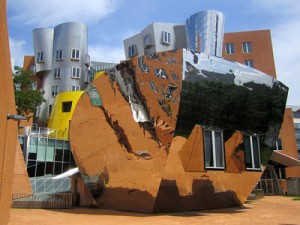
Demolition of Building 20 and recreation of Stata Center Source: Wally Gobetz via flickr
Alexandra Lange’s “Innovation Campus” lends new meaning to the phrase, “Thinking outside of the box.” The author uses ethos to persuade the audience. She is a journalist who has built a reputation as an architecture and design critic. Lange’s work has been showcased in The Architect’s Newspaper, Design Observer, Metropolis, New York Magazine, and The New York Times. Universities stakeholders may find Lange subjective approach credible.
“If the Silicon Valley creation myth starts in Steve Job’s garage (now a designated historic site), the creation myth on campuses starts at M.I.T.’s Building 20.” The Silicon Valley myth erupted from the presumption that Steve Jobs launched a start- up in the famous garage and built it into the world’s most valuable company. Steve Jobs did not create things wholly; however, he was gifted at organizing ideas that define the future. Like the Silicon Valley myth, brainstorming was birthed inside the walls of M.I.T.’s Building 20.
“Though studies have shown that proximity and conversation can produce creative ideas, there’s little research on the designs needed to facilitate the process.” Collaboration can take place over distance. Communicating and networking via email, instant messaging, face-time, and conference calls are communication technologies. However, I believe face-to-face conversation is more effective. Close proximity does make communication easier because it encourages social interaction.
“There’s also much more to do with your hands than take notes in class:” This sounds like the structure appeals to the hands-on learner. I am wondering if the design takes into account the kinetic,auditory, and visual learner. I attended a fines arts magnet school that focused on learning through visual arts. The arts were not of interest to me; therefore, I soon transferred to an academic magnet school. Lange suggests that the design will foster creativity . Can creatively be learned?
“Instead, there will be options so that people can choose how they like to work, from open-plan spaces by the windows, to a roof deck with a garden, to huddle rooms for groups of five or less.” This idea supports the thesis in the article, “Recognizing Campus Landscapes as Learning Spaces” by Scholl and Gulwadi.
“As you begin to understand how people work together, there is an ideal size of collaboration.” In order to make an idea come to life, sometimes it takes many people. This is evidenced through Steve Jobs. Jobs had the idea, but he could not put the plan into action. It took other people to make Apple come to life.
“One thing about the building is it has no formal classrooms, and no faculty or staff offices,” If there are no offices, where do faculty and staff go to collaborate?
“But the pressure on administrators to change their campuses may soon come, not just from above and within, but from below.” Student turnover rates and graduates under performing in the workforce will force administrators to redesign their campuses.